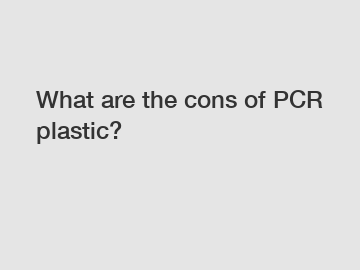If you are looking for more details, kindly visit EcoPlas.
Polymerase chain reaction (PCR) is an essential tool used in molecular biology to amplify specific DNA sequences. One of the key components of running a successful PCR reaction is the plasticware used for the reaction mix. While PCR plastics are convenient and widely used, there are some drawbacks associated with their use. In this article, we will discuss the cons of PCR plastic and how they can impact your experiments.
**Risk of Contamination**.

One of the main drawbacks of using PCR plastics is the risk of contamination. Contamination can occur through a variety of sources, including the plastic itself. PCR plastics are often disposable, single-use products that may not be manufactured to the high standards necessary to prevent contamination. In addition, the plastic can become electrostatically charged, leading to the attraction and retention of airborne contaminants, which can then be introduced into the PCR reaction mix.
**Leaching of Inhibitory Compounds**.
Another con of PCR plastic is the potential leaching of inhibitory compounds into the reaction mix. PCR plastics are typically made from polymers such as polypropylene, which can contain compounds that inhibit PCR reactions. These inhibitory compounds can leach out of the plastic during the PCR process, leading to reduced amplification efficiency and false negative results. This can be particularly problematic when working with low template DNA samples or when trying to amplify challenging targets.
**Inconsistent Performance**.
PCR plastics can also suffer from inconsistent performance, leading to variability in PCR results. Different brands and batches of PCR plastics may have slightly different properties, such as surface charge, hydrophobicity, and optical clarity. These differences can affect the efficiency of PCR amplification by interfering with the binding of DNA primers, the interaction of DNA polymerase with the template, or the detection of fluorescent signals. This inconsistency can make it difficult to reproduce results between experiments or across different labs.
**Environmental Impact**.
Another important consideration when using PCR plastics is their environmental impact. PCR plastics are typically made from non-biodegradable materials, such as polypropylene or polystyrene, which can persist in the environment for hundreds of years. The widespread use of disposable plastics in molecular biology research leads to a significant amount of plastic waste being generated, which can have harmful effects on the environment. Finding ways to reduce, recycle, or reuse PCR plastics is an important step towards minimizing their environmental impact.
**Conclusion**.
In conclusion, while PCR plastics are a necessary component of running PCR reactions, they come with some disadvantages that researchers should be aware of. These cons include the risk of contamination, the potential leaching of inhibitory compounds, inconsistent performance, and their environmental impact. Understanding these drawbacks and taking steps to mitigate them, such as using high-quality plastics, practicing good lab techniques, and exploring alternative materials, can help researchers improve the reliability and reproducibility of their PCR experiments.
If you have any questions or would like to learn more about PCR plastics, please feel free to contact us.
Read more
If you are looking for more details, kindly visit PCR Plastic Recycling.



Comments
All Comments (0)